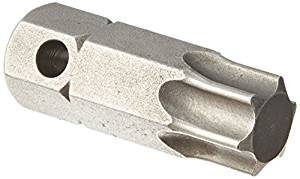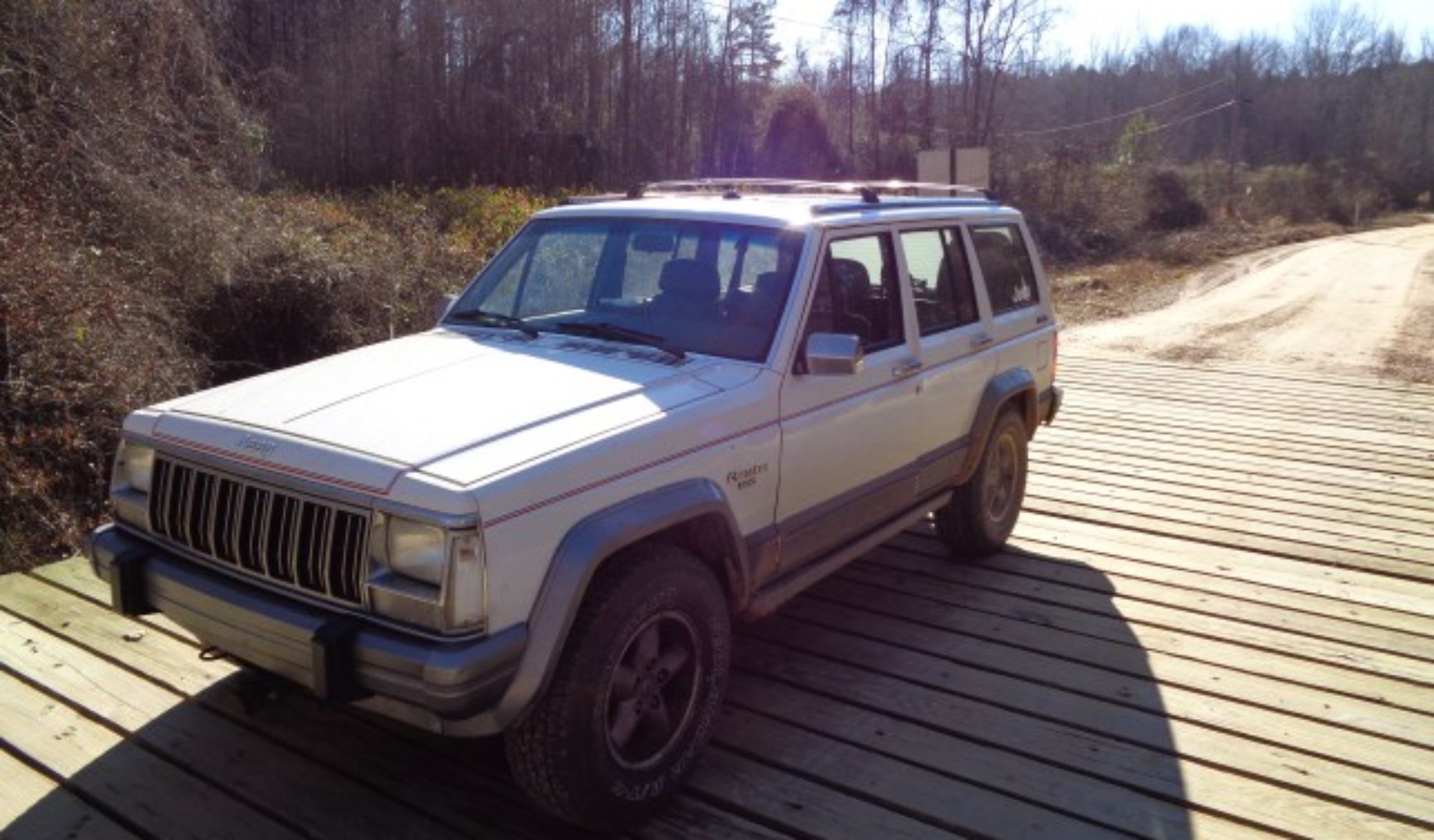Black Mountain Off Road Adventure
The XJlist folks met once again for their Annual Fall Crawl at Black Mountain in Harlan Ky. The trails of Harlan County offer a wide variety of trails and fun. This year however a new varied element was added to the mix: changing weather.
The group began arriving Thursday morning coming from east west and south to meet at camp 3 half way up Black Mountain. Most traveled in rain all morning to reach the park where the skies were clear. But the morning rain had made the step gravel climb to the camp site very slick.
After paying for camping and buying a Harlan County Sticker, I asked the guy about the road. He assured me that it had been graded since I had been there in the spring and if I made it up then I should have no trouble. Note that he drives a Sentra.
I put the Suburban in Low Range and headed up the hill. I noticed a bit too late that it looked like someone had had a hard time getting up and had done a lot of spinning. I got on the throttle to build momentum but it was too little too late and I came to a stop with all four wheels spinning. Then I started moving backward.
I tapped the brakes and the trailer brakes helped hold it in place. However moving backward turned up not to be an option either as I started to slide toward the edge of the road where there is a huge drop off. I did however slide far enough tot the right for Jenny to squeeze past and hook a strop to the front. With a tug from her Jeep, I made it up just fine. I looked back and saw Neal’s Jeep parked on the side and realize that he must have made it to the same spot with similar results and unloaded his Jeep to make it up the hill.

Once at camp, we set up our tent and greeted our friends. The weather was quite warm and then suddenly a breeze popped up. Matt’s tent was set up but not staked. He looked up juts in time to watch it float over the edge of the cliff into the kudzu below. He managed to catch it before it got out of reach unlike a few years ago when he had to don his repelling gear and be winched down and back to get his tent from a similar incident.

After a leisurely time of unloading, airing down and disconnecting sway bars, we headed out to explore some new trails. We began with a new cut off form trail 45 called Pappy’s Bypass. It was a narrow muddy trail with lots of switchbacks and great views of the fall leaves in the valley below.
We reached White Tail camp and the weather shifted. It went from warm and clear to thunder and hail. We sought cover under the shelter and watched as the storm blew over quickly and then shifted to snow. As the snow died down we began to play on the rocks and hill climbs there.





After some play time we headed back along trail 15. This trail is fun when dry and very exciting when wet and slick. The very last section consists of a couple of very steep switchbacks where you just have to make a controlled slide down. Lots of fun to end the first day.
Back at camp Evan had arrived and started a fire. We sat around and caught up with our friends and cooked supper.
The next morning we saw snow on the upper parts of the mountain but none in our camp. We headed up to Middle Fork and considered a run up 15. Several of the group played on the first steep hill. Some made it and some did not. Knowing the second hill is the one that is really a challenge in the wet, we split into two groups – Swampers and other tires.
We met back up where 15 and 12 come together. Surprisingly we arrived at the rendezvous point at exactly the same time. We merged the groups back together and headed to ward the stadium area which has several hill climbs. Along the way Neal noticed a small rock garden so we went back and played on it and posed for photos on the hills there.




Matt noticed his cross member had come loose and his transfer case was dangling. We made a very temporary trail fix and left his Jeep there while we explored further down the trail.
The snow was really coming down at this point. Those of us with out doors were getting our seats soaked as Matt sat in my passenger seat and soaked his pants. Cold and wet we made out way to the Truck Challenge course and the soup bowl.
We quickly found a pile of rocks to play on and Josh and Evan gave a go at swimming in the soup bowl. I started to explore the area a bit when I heard a strange noise. The noise turned out to be my front drive shaft separating from the front yoke. One of the strap bolts had sheared off and I lost a cap in the process. I pulled the shaft and prepared to make my way back to camp in 2wd.
Back at camp, Matt started work on his cross member while I worked on extracting the broken bolt from the yoke. Once it was out, Wayne Sr gave me a spare bolt and a strap. Evan donated a U joint. I pressed in a new joint and waited for daylight to install the shaft.
Matt had no luck fixing his cross member so he elected to leave his Jeep at camp and ride shotgun. We built a huge fire and enjoyed telling stories well into the chilly night.
The next morning it was cold and clear with lots of snow visible o the mountain. The plan was to go back up the twisty trail 15 and then work our way back through the massive park on trail we have not run before.
Trail 15 took most of the morning as Mitch G got scarily sideways near the top and required a strap and assistance from Frosty’s Toyota to get pointed back up the hill.
Josh made a run and his Swampers pulled him up easily. So we staged him with a strap near the top to give a tug to those who needed it. Jenny made a run and had a huge mudslinging fun time making it look easy. I followed her up and made it without assistance as well.
Once we had all the Jeeps to the top, we headed on to White Tail for lunch. We ate lunch under spitting snow and then headed out for a trail ride. Neal and Evan headed to town for fuel while I lead the group toward trail 22. We had planned to run T.R.O.U.B.L.E. but when we got there it was covered in very slick leaves and it looked like no one had run it in a while. The consensus was that it would be more fun to go up than down so we elected to skip it for the time.
I lead the group on to 18 which has two fun climbs back to the main trail. The first had a big log on the side that was impossible to avoid in the slick conditions. I think Jenny’s bumper cap was the only casualty of the otherwise very fun climb. The second climb was fun as well with a big rock that scraped a few wheels as we climbed.
We all collected at the Lower rock garden and played there for a while. Jenny made good use of her new Crusher tires and crawled easily through the lower section while frosty and Josh ran the garden backwards toward her.
After getting our fill of the Rock Garden we headed off to let Jenny redeem herself on rail bed. Last time here, she slipped on the exit and had to be extracted.
This time Rail bed was even more intimidating. The rocks were wet and slick and most of the smaller ones and even some of the big ones had washed down the hill.
Near the three quarter mark of the trail, Mitch popped a tire off the bead and Neal drove backwards down the trail so his onboard air line would reach. After the tire repair, Neal positioned his Jeep to use the winch to help people over the nasty V notch made by two big rocks.
There are three exits to rail bed. One requires a lot of clearance to get over a huge boulder. The other is the one that Jenny slipped off of last time and is now even more narrow and dangerous. The only viable option for most of us was a steep muddy climb. We positioned a winch at the top and another Jeep with a strap to assist.
Jenny made it over the V notch fine and was almost up the muddy hill when she hung her diff on a rock and had to have a strap to help her get the rest of the way out. I got hung on the same rock and had to have a bit of a tug as well.
Once every one was up and out, we gathered some fire wood and made a dash back to camp. The sunset on the snow covered mountains made for a beautiful drive back to camp.

The crew made dinner in record time and we enjoyed our huge steaks and potato boats as darkness settled in. Me enjoyed looking up at the bright stars and enjoyed another evening of fellowship around the camp fire. For desert, we warmed up some apple and pumpkin turnovers that my mother made for the trip.
Sunday morning dawned crisp and cold and we all fought ice as we packed up our tents and gear. A heavy layer of frost covered out trailers and everything left outside. We took our time loading up and the remaining group made a final stop at the Harlan Huddle House before parting ways.
This trip was one of the most adventurous yet for me even if we did not conquer as many obstacles. The cold wet weather made simply driving the trails a challenge. Three days of sliding and sliding has defiantly given me a better feel for driving my Jeep and improved my confidence. Black Mountain Adventure area sure lived up to its name this trip!







































































